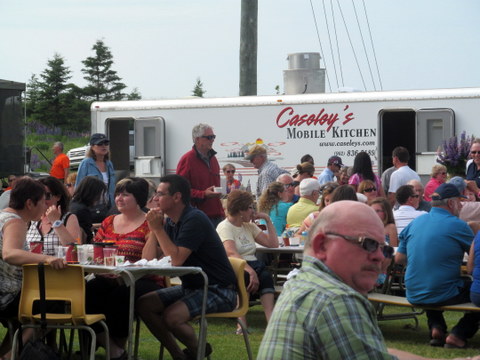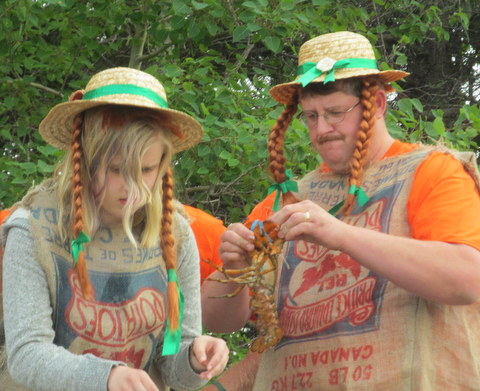Recently,
Greg and I visited Michael Smith’s Fire Kitchen at the Inn at Bay Fortune,
purchased by the famous chef earlier this year and extensively renovated. The
old kitchen and way of food service are out, and a new method is very much in. So
popular, in fact, that we had to wait a couple of weeks for a reservation to this family-style eating experience.
The previous
day, we received a reminder: arrive at 6:00 for the oyster-shucking cocktail
hour. So, what did we find when we got there — at 6:01? In the first place, not many
other people. I knew being on time would
be the equivalent of being too early; my dining companion still has to learn
this. However, we were warmly greeted by a chilly hostess in the cool autumnal
air outdoors. She explained the procedure for dinner, then went indoors to find
a coat!
We admired
the new reception area (blond wood ceiling and birch trunks room divider). Once the doors to the kitchen were open,
which reminded me of waiting for the doors to open at the Maple Dining Room at Christie Gardens, a
few of us straggled into what was the former main kitchen. We ate, not Colville Bay, but Fortune Bay oysters
harvested about as locally as you can get — about 500 feet away in the sea. Local provenance
is the byword here.
With Bloody Mary ice
on top, they were delicious.
We eschewed
the gin and tonic, figuring at $13 a mason-jar drink, we could imbibe at home
for much less money and equal effect.
Greg and I
were not quite sure what to do with ourselves for the next 45 minutes while we
waited for dinner to begin, so we sat in the lounge and watched other people
arriving, while at the same time avoiding making eye contact with them, as they
were with us. Is everybody here an introvert?
Carrying our
coats with us, as the former coat closet was now a mini-store for cook-books by Michael Smith, we decided to explore the
dining room, found our name chalked on a slate, determined we would have to sit
across from each other at dinner (no sotto voce comments possible, darn it), and hung our coats on the back of our chairs.
More people
had arrived and seemed to be gravitating to the other end of the long room where the
new ovens are. There, we found the next stage: pastrami salmon with lemon caper
aioli being assembled on crackers by a very young man (to our elderly eyes). He
could barely keep up with the demand.
Mmmm good! There was also smoked beef with beer mustard, also very
good as, initially, the beef was not too rare for my liking.
More drinks could
be added to our tab were we to indulge in local beers. Again, we passed: too pricey.
I got a big
kick out of talking to the young chef unwrapping the baked beets plucked
earlier in the day from the Inn’s garden. Rail thin and wearing a baseball hat
backwards, he was cheery and chatty. I asked him, wasn’t the heat from the fire
a bit much on his back and he said he was used to it. He told us they
burn maple, birch and something else and that there is not a lot of hardwood on
the island so they have to source some of the wood in New Brunswick …well,
still pretty local! (All the gravel for driveways here comes from New Brunswick
too, by the way. Some things just can’t
be helped.)
 |
| Here is our take-home menu. |
In addition
to place-setting menus, the courses for the night’s feast were written on the wall on brown wrapping paper suspended
from what looked like an antique paper
roll, with an impressive serrated edge
at the bottom. On another wall, the 40-plus ingredients for the salad were
listed. Inspecting these items relieved me of the necessity of talking to total
strangers. I said to Greg, we should have gotten a group together, so we would know
people.
However,
that all changed when we got to our tables. We were saved by a retired teacher and co- owner of tourist cottages, who introduced herself and encouraged
the rest of us to do likewise. We did and soon we were finding lots to talk
about with one another.
Course after
course arrived — with explanations from one of the chefs as to their
significance. Sourdough yeast for the bread takes a month to develop from potato mash, so
even the yeast is local! The resulting
12-grain Red Fife sourdough bread was irresistible, especially with brown
butter.
The Taste of
the Island Board was delectable. The peas could have been younger,
but the dilled beans were yummy. There was way too much pate, delicious though
it was, and too few crackers. Jeff
McCourt’s cheese from Glasgow Glen was pizza-flavoured — and it was “gouda.”
Cue the
chowder: all local sea food, delicious.
The
invitation to smash the sand crusted on the baked halibut drew several
volunteers. After whacking the sandy crust, the participants shared their adventure on their I-phones, while the chefs removed cabbage leaves from the fish, placed there to protect it
from the grit. Served with cauliflower, it was a bit bland… Even the spicy sea
rocket provided from local beaches by the Inn’s forager didn’t spark it up quite
enough.
However, the
occasion itself kindled energy in the crowd.The conversation noise
level rose, while course after course
was presented. I found out the back stories of my seatmates (I already pretty
much know Greg’s). Not telling them here … as what is said in the dining room
stays in the dining room. It was just so convivial.
A 90-year old woman and her 50-year old son shared a birthday, and of course
everyone in the room belted out Happy
Birthday when their cake was marched in.
Want to know where on the Island to go for afternoon ballroom dancing
lessons? Now I know.
I didn’t think I would like family style dining, but it
turned out I do. Four hours after we arrived, we all said goodbye and wended our happy ways home.
If I had a
word of advice, I’d say make the main entree portions a bit smaller. We sent
way too much chicken back to the kitchen as we simply couldn’t eat it all. Same with the excellent brown butter mashed
potatoes. The beets, zucchini and
roasted onions were very enjoyable, and the quantity was just right.
Also I was
told that some of the garnishes the forager finds are few and far between on
the beaches. Now that local plants are used in quantity at many restaurants, I
worry we might be enjoying the results on our plates but over-foraging in the
woods and beaches.
Nevertheless,
I am looking forward to returning anytime I want an energetic, participatory,
delicious dining experience. Good for Chef Michael for embarking on this
rollicking adventure in Prince Edward Island hospitality and local foods.























































